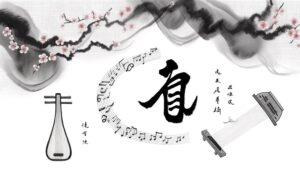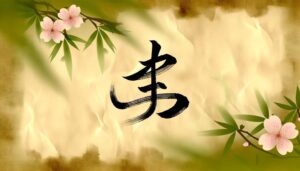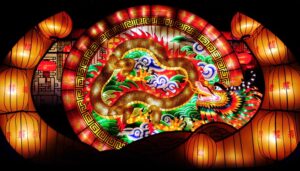What is the Chinese Symbol for Warrior?
The Chinese character for 'warrior' (武) reflects a deep historical and cultural heritage. Originating from the Zhou Dynasty, it combines symbols for 'foot' and 'spear,' signifying the act of combat.
Over centuries, its graphical form evolved, embodying physical strength, honor, and duty. In martial arts, it represents discipline, mastery, and philosophical introspection.
The warrior symbol is prominent in various art forms, literature, and modern media, often embodying resilience and inner strength. To understand its extensive significance in Chinese culture and its influence across time, exploring further will be insightful.
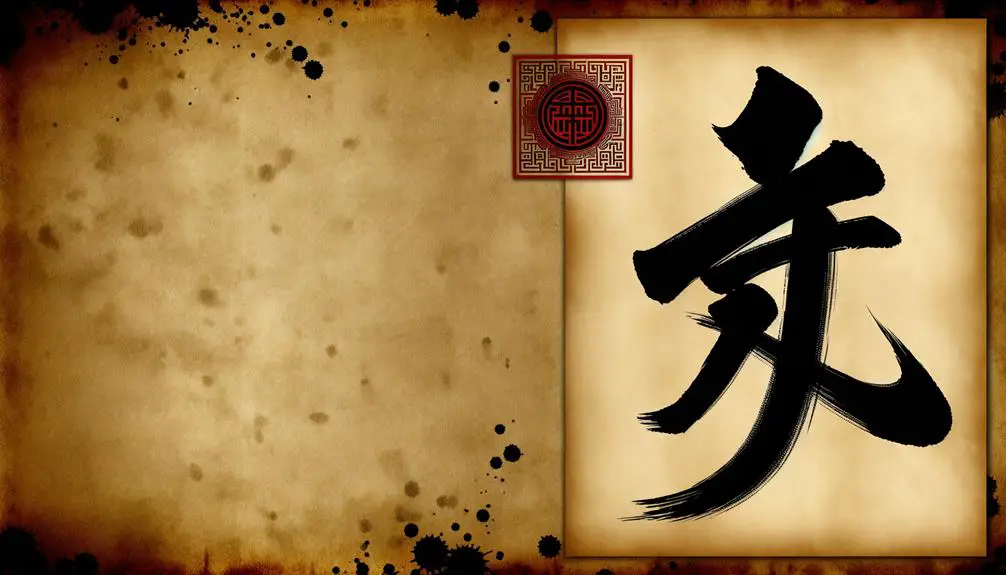
Key Takeaways
- The Chinese character for 'warrior' originates from the Zhou Dynasty and combines radicals for 'foot' and 'spear'.
- It signifies physical combat and the strategic nature of a warrior.
- The character embodies values such as physical strength, courage, honor, and duty.
- It holds profound significance in martial arts, symbolizing discipline, honor, and mastery.
- The character has evolved through various scripts and is integral to Chinese cultural identity.
Historical Roots of 武
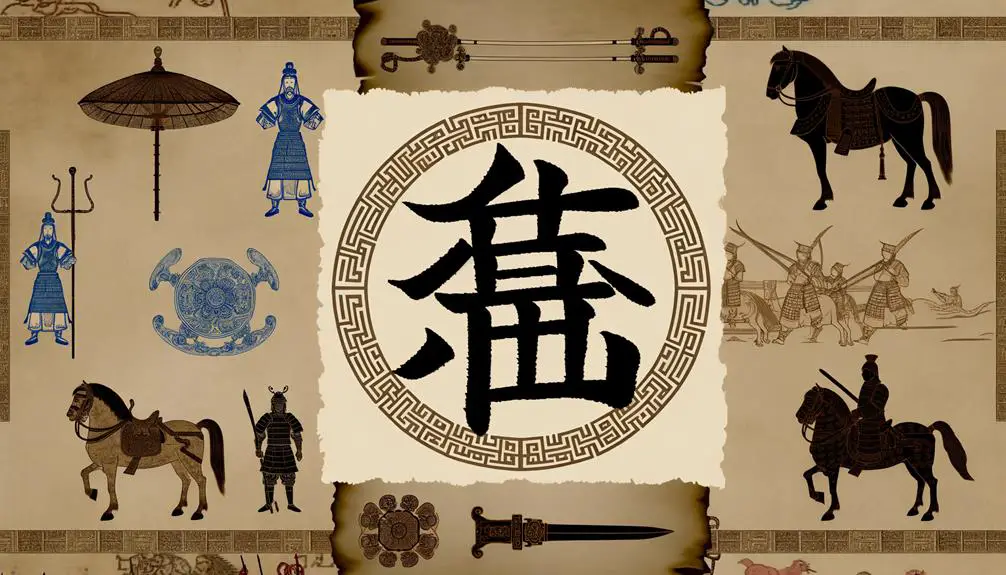
The Chinese character 武 (wǔ), symbolizing 'warrior' or 'martial,' has its historical roots deeply embedded in ancient Chinese civilization and military culture. Originating from the Zhou Dynasty (1046–256 BCE), this character embodies the essence of martial prowess and the societal importance of military strength.
The structure of 武 combines the radicals for 'foot' (止) and 'spear' (戈), reflecting the fundamental components of ancient warfare. This amalgamation signifies not merely the physical act of combat but also the strategic and disciplined nature of a warrior.
Throughout Chinese history, 武 has been revered, representing the ideal of martial virtue and the safeguarding of peace through strength, playing a crucial role in shaping Chinese cultural identity and values.
Evolution of the Character
Tracing the evolution of the character 武 reveals significant shifts in its graphical form and semantic nuances over millennia. Originating in ancient oracle bone script, the character initially combined pictographic elements representing a weapon and a foot, symbolizing martial prowess.
As Chinese script evolved through bronze inscriptions and later into seal and clerical scripts, 武's form was refined for clarity and efficiency. By the time of regular script standardization in the Han dynasty, it had adopted its modern shape, encapsulating both martial strength and cultural prestige.
This evolution reflects broader linguistic trends and the contextual importance of warriors within Chinese society, showcasing an enduring legacy embedded in the character's morphology and meaning.
Philosophical Significance
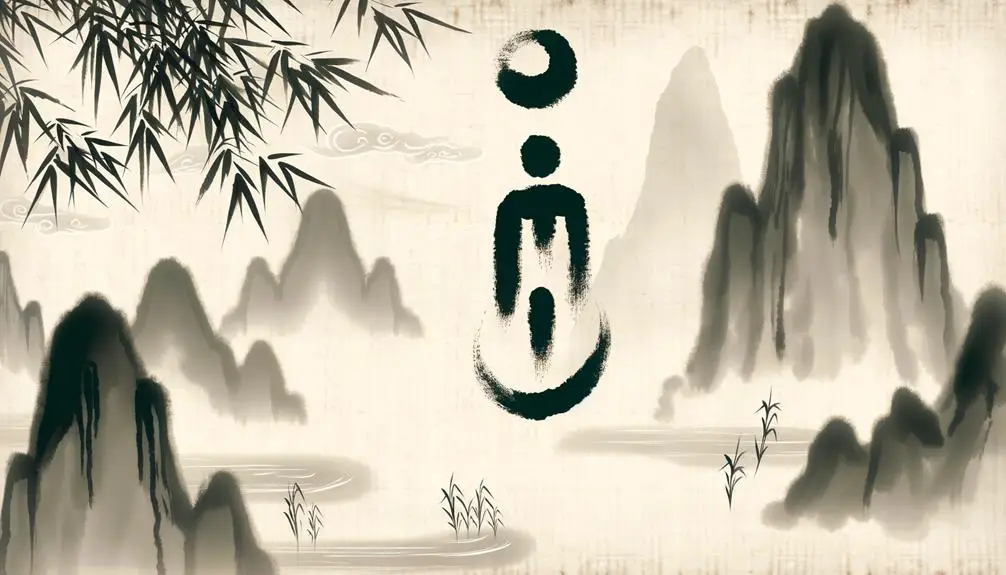
The Chinese symbol for warrior encapsulates profound philosophical ideals, embodying not only physical strength and courage but also intrinsic values of honor and duty. These attributes reflect a holistic understanding of the warrior's role in society, transcending mere combat to include moral and ethical responsibilities.
Consequently, the symbol serves as a multifaceted representation of both personal valor and societal commitment.
Strength and Courage
In Chinese culture, the warrior symbol embodies profound philosophical concepts of strength and courage, reflecting an individual's inner fortitude and unyielding spirit.
Strength, represented by the warrior, is not merely physical prowess but an enduring resilience that withstands adversities. This resilience is rooted in the Confucian virtue of perseverance, emphasizing moral integrity and steadfastness in the face of challenges.
Courage, on the other hand, transcends mere bravado; it signifies the capacity to confront fear and uncertainty with a composed and resolute heart. This duality of strength and courage underscores a holistic understanding of the warrior, integrating both mental and physical dimensions.
It is a reflection to the enduring values that shape character and guide actions in Chinese philosophy.
Honor and Duty
How does the concept of honor intertwine with the sense of duty to form a cornerstone of the warrior ethos in Chinese philosophy?
In Chinese thought, these principles are inseparable, each reinforcing the other to guide a warrior's conduct. Honor (名) is seen as the moral compass, while duty (責任) represents the steadfast commitment to one's responsibilities. Together, they form a holistic framework:
- Moral Integrity: Upholding ethical standards even in adversity.
- Loyalty: Demonstrating unwavering allegiance to one's sovereign and comrades.
- Courage: Facing danger and making sacrifices without hesitation.
- Service: Prioritizing the welfare of the community above personal interests.
This synthesis of honor and duty safeguards that the warrior not only excels in martial prowess but also embodies the virtues esteemed in Chinese culture.
Cultural Depictions
The cultural depictions of the Chinese symbol for warrior () have evolved greatly over time, manifesting in both historical art and modern media.
In traditional Chinese art, the symbol often appears in classical paintings and sculptures, embodying the virtues of bravery and honor.
Contemporary media continues this legacy, portraying warriors in films, video games, and literature, thereby ensuring the enduring relevance of the archetype in popular culture.
Historical Interpretations in Art
Historical art across various Chinese dynasties offers profound insights into how the symbol for warrior has evolved in cultural depictions. The transformation is marked by distinct artistic elements reflecting societal values and martial ideologies of the time.
Key historical interpretations include:
- Han Dynasty: Warriors depicted in terracotta sculptures emphasize strength and readiness, portraying a disciplined martial class.
- Tang Dynasty: Artistic representations highlight ornate armor and elaborate weaponry, symbolizing the era's military sophistication and cultural prosperity.
- Song Dynasty: Paintings often depict warriors with a scholarly demeanor, merging martial prowess with intellectual refinement.
- Ming Dynasty: Illustrations in scrolls and murals focus on strategic acumen and leadership, reflecting the importance of military strategy.
These historical depictions collectively underscore evolving perspectives on the warrior's role in Chinese society.
Modern Media Representations
Reflecting contemporary values and technological advancements, modern media portrayals of the Chinese warrior emphasize a blend of traditional heroism with futuristic elements. This synthesis is evident in various platforms, including films, video games, and graphic novels.
Characters like those in the movies 'Crouching Tiger, Hidden Dragon' and 'The Wandering Earth' exemplify this fusion, where ancient martial arts coexist with advanced technology and sci-fi aesthetics. These depictions resonate with global audiences, presenting the warrior as both a guardian of cultural heritage and a symbol of progress.
Through such narratives, the enduring spirit of the Chinese warrior is reimagined, ensuring its relevance in a rapidly evolving digital age while maintaining a deep connection to its historical roots.
Modern Interpretations
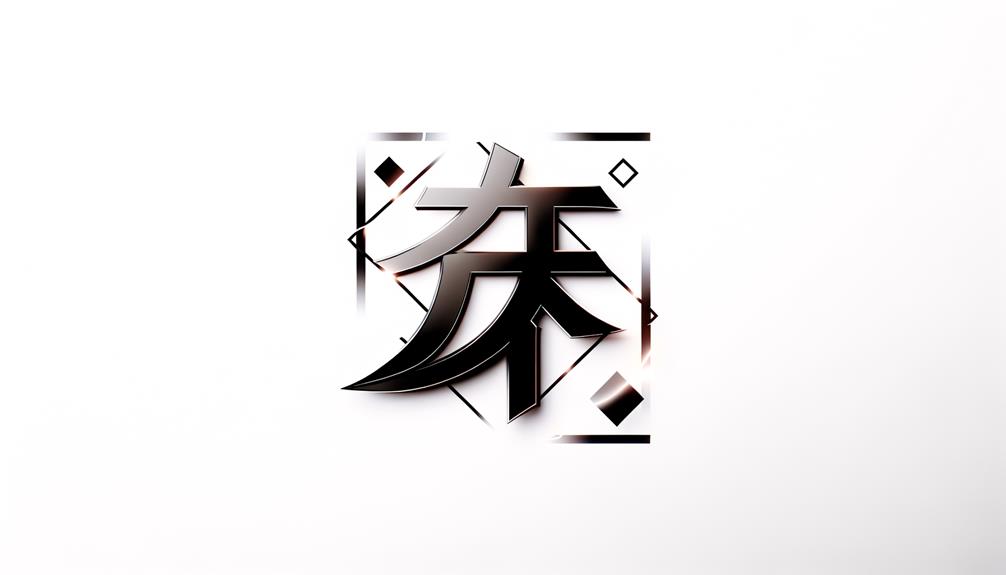
In contemporary contexts, the Chinese symbol for 'warrior' often transcends its traditional martial connotations to embody ideals of resilience, courage, and inner strength. This broadened interpretation finds relevance in various spheres of modern life, reflecting the multifaceted nature of what it means to be a 'warrior' today.
- Personal Development: The symbol is frequently invoked in self-help literature to inspire individuals to overcome personal challenges.
- Corporate Culture: Companies may adopt the symbol to promote a culture of perseverance and innovation among their employees.
- Art and Literature: Modern artists and writers use the symbol to represent characters or themes that exemplify fortitude and moral integrity.
- Social Movements: Activists may utilize the symbol to galvanize support and convey a message of collective strength and resistance.
Such interpretations underscore the enduring relevance of the 'warrior' symbol.
Symbol in Martial Arts
Within the world of martial arts, the Chinese symbol for 'warrior' holds profound significance, embodying the essence of discipline, honor, and mastery. This symbol, known as 武 (wǔ), is not merely a character but a representation of the martial artist's journey. It encapsulates the core values that practitioners aim to embody through rigorous training and philosophical introspection.
| Aspect | Meaning |
|---|---|
| Discipline | The rigorous training and self-control required |
| Honor | The ethical and moral standards upheld |
| Mastery | The ultimate goal of skill and understanding |
In martial arts, 武 (wǔ) serves as a constant reminder of the dedication needed to achieve excellence, guiding practitioners towards personal and martial perfection.
Conclusion
The character 武, embodying the essence of the warrior, serves as a bridge between ancient traditions and contemporary interpretations.
It symbolizes strength, honor, and philosophical depth, transcending mere martial prowess to encompass a broader cultural and ethical spectrum.
Its evolution from historical roots to modern martial arts reflects a timeless narrative of resilience and wisdom.
Therefore, 武 stands as an enduring emblem of the warrior spirit, intricately woven into the fabric of Chinese heritage and philosophy.


